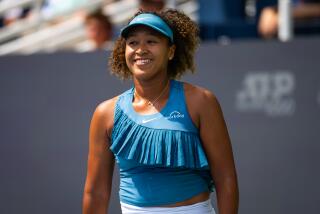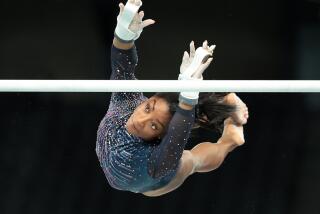Little Mirai Nagasu relies on a big support group
CLEVELAND — The ice is so big and figure skater Mirai Nagasu always looks so small, even after a growth spurt that allows the Arcadia resident to proudly proclaim she’s nearly 5 feet 3.
She may seem a solitary figure when she takes to the ice at Quicken Loans Arena today for the first phase of the U.S. Figure Skating Championships, but she will not be out there alone as she pursues her second consecutive national title.
Nagasu will reflect the labors of the coaches, stylists, costumer and choreographer who have shaped her -- and her routines.
It’s not unusual for elite athletes to consult specialized coaches, strength trainers or nutritionists in their quest for an NBA title or Olympic gold medal.
Top-level figure skaters typically have a primary coach, a coach they visit for summer sessions or for jump doctoring, and a choreographer.
Nagasu, a sprite of 14 when she won the U.S. women’s title last year, draws upon a posse of seven. That’s roughly one person for every minute she will be performing on the ice here.
“When you have a teenager like Mirai it takes this much,” said Charlene Wong, Nagasu’s primary coach. “Maybe she needs more.”
Relying on a platoon of supporters isn’t a new concept in figure skating. Olympic champions Peggy Fleming and Dorothy Hamill each worked with several coaches.
But Nagasu and other skaters of her generation have taken it to a new plane.
Alissa Czisny, third at the 2007 U.S. championships, lists five coaches and three choreographers on her resume this season. Rachael Flatt of Del Mar, second last year and a prime contender this year, lists five coaches and a choreographer.
Adding consultants to an already pricey tab for ice rental, basic coaching and off-ice training can push yearly costs to more than $60,000 for top skaters.
Nagasu, whose parents own a small sushi restaurant in Arcadia, received money from a skating foundation operated by former U.S. champion Michael Weiss, from patrons of her old rink in Pasadena and from a fund established by U.S. Figure Skating.
But her success last year shows the benefits of working with the seven-member team.
Wong coordinates everyday training and is a liaison to Nagasu’s parents, Japanese immigrants who are media-shy. Nagasu also consults Sondra Holmes and Sashi Kuchiki, who are renowned among skaters as jump doctors who can fix your wobbly double axel or balky triple loop.
Choreographer Lori Nichol, another member of the team, has worked with a parade of world and Olympic champions. She knows how to blend artistry with the athletically demanding moves that earn points under the sport’s judging system.
Nagasu has thrived under their tutelage, perhaps partly because she is what Wong called “an independent thinker.” That’s a nice way of saying Nagasu’s delicate appearance masks an iron will.
Despite persistent pain on the top of her right foot -- she said it surfaced last summer but one of her coaches said Nagasu mentioned it last season -- she competed in two Grand Prix events this season and appeared in some benefit shows. That’s after performing in Japan over the summer.
She fell twice in the long program at Skate America in October and finished fifth. She considered withdrawing from the NHK trophy competition in Tokyo in late November but didn’t. The result was another two-fall long program and an eighth-place finish.
Throw in the fact that the top two women here will represent the U.S. at the world championships at Staples Center in March, no matter how you spin it she has a lot with which to contend.
“I have to say it was a lot easier being 14 last year with no thoughts and it was just easier to get through my programs because I was always energetic and my metabolism just was on fire 24/7,” Nagasu said during a conference call last week.
“But now I’m growing older and teenage adolescence has hit me. It’s getting a lot harder, but it’s not anything I can’t get past.”
Out of deference to her sore foot, she didn’t practice her flip or lutz jumps while preparing for this competition. She will have to land them to earn points and prove her versatility. “She’s had a difficult year competitively. I really feel for her,” said Bob Paul, who has coached her for nine years and mostly works on her style and presentation.
“She’s a very bright young lady with an amazing amount of talent. Last year everything fell into place and she won, which was maybe a little bit early.”
Nagasu was the second-youngest U.S. women’s champion last year at 14 years 9 months old -- one month older than Tara Lipinski was in 1997. Lipinski didn’t repeat as U.S. champion but won gold at the Nagano Olympics
“I’ve never thought it was a bad thing to win the national championship,” Wong said, “but with the championship so, too, comes responsibility and scrutiny regarding every single decision she makes.
“She’s in a fishbowl, but that’s OK. She can take it.”
Nagasu, a sophomore at Arcadia High, began skating when she was 5 and first made a splash in 2007, when she won the U.S. junior title and finished second to Caroline Zhang of Irvine at the world junior competition.
She won the U.S. senior title last year but was too young to compete at the world championships and had to return to the world junior event. She was third in that competition, behind Flatt and Zhang.
Nagasu said after the NHK event she began a series of exercises designed to strengthen the muscles around the tender area of her foot. Wong said Nagasu “didn’t stay off the ice as much as the doctors might have liked her to after NHK,” and whether that’s independent thinking or foolish willfulness will become apparent in the next few days.
“Her components, freedom of movement, spins, flexibility,” Wong said. “We’ll see how the jumps are. It’s going to be tricky.”Nagasu seems to know that too.
“I’m going into the U.S. championships not as the champion, just as one of the skaters who wants to show everyone that she loves to skate and I just want to attack my program out there,” she said. “Because to me, this competition isn’t really a competition against other skaters. It’s a competition against myself and I want to overcome the nervous, evil side of me, I guess.”
At 14 she had no nerves. At 15, well, that’s different.
--
--
(BEGIN TEXT OF INFOBOX)
Charlene Wong
Primary coach.
Coordinates decisions with Nagasu and her parents.
--
Bob Paul
The 1960 pairs gold
medalist was her “Saturday coach,” working on a jump or spin she didn’t refine earlier in the week. He also helped enhance her style by leading her through routines off the ice in front of a ballet barre.
--
Sondra Holmes
Jump specialist.
Double axel fixer.
--
Sashi Kuchiki
Jump specialist.
--
Sandy Gollihugh
One of Nagasu’s first
coaches. A familiar face.
--
Renee Roca
A three-time national ice dance champion and now a choreographer, she works on the emotional parts of the performance. Replaced Jim Yorke, who died last year.
--
Lori Nichol
Choreographer to many Olympic and world
champions, including
five-time world champion Michelle Kwan.
--
U.S. CHAMPIONSHIPS
Today-Sunday
at Quicken Loans Arena in Cleveland
More to Read
Go beyond the scoreboard
Get the latest on L.A.'s teams in the daily Sports Report newsletter.
You may occasionally receive promotional content from the Los Angeles Times.








